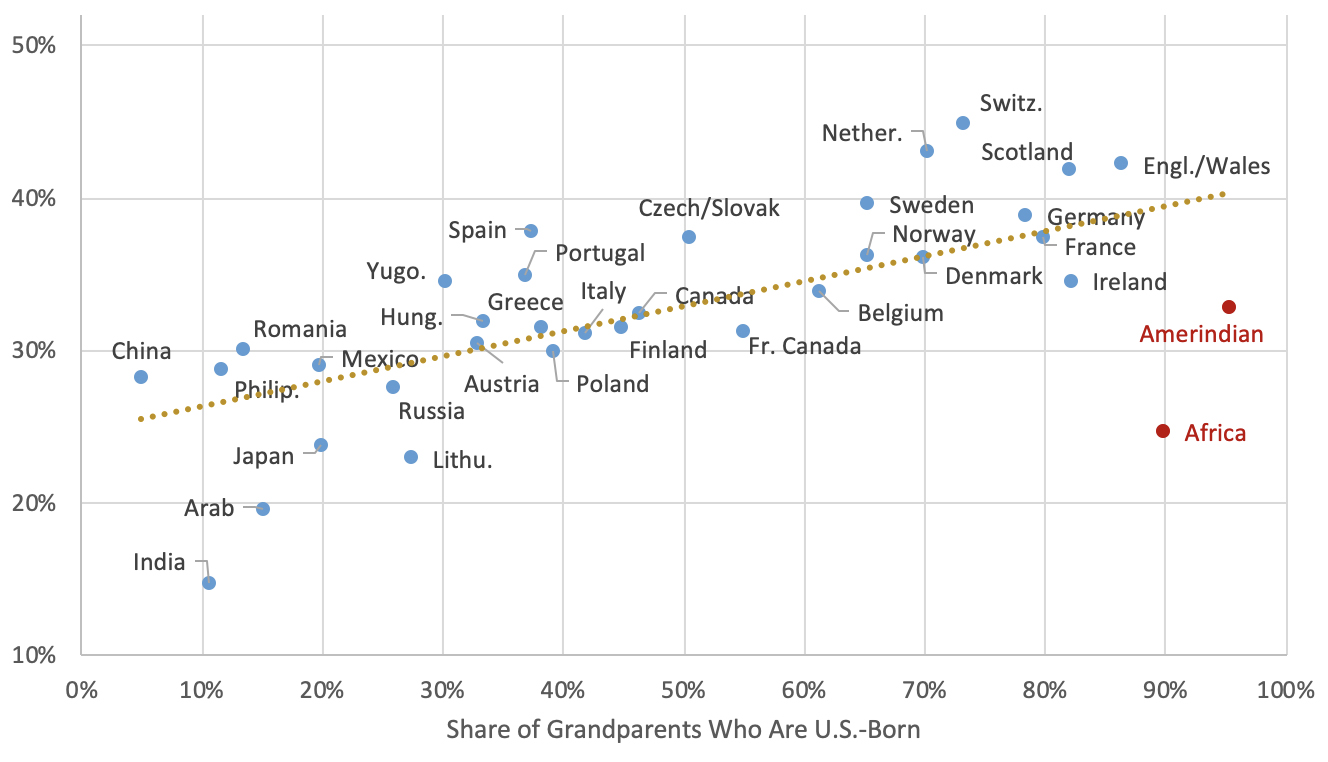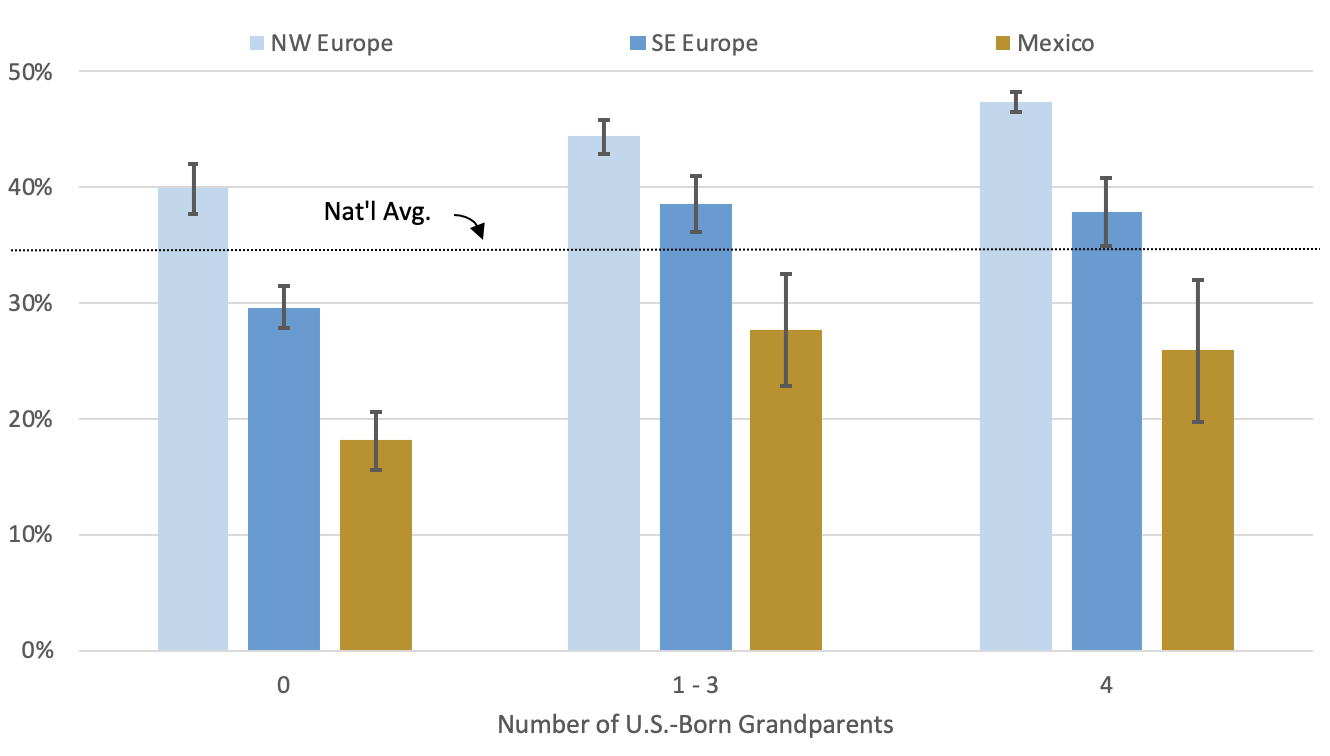
[ad_1]
Over at Aporia journal, Noah Carl used the Basic Social Survey (GSS) to look at the political preferences of various American ancestry teams. “There’s a comparatively clear sample,” he concluded. “Individuals of Northern European origin are essentially the most conservative; these of Southern and Japanese European origin are intermediate; and people of Asian, African, or Mexican origin are the least conservative.”
This result’s putting when considered by way of an immigration lens. Depart apart the African-origin respondents for a second as a result of most of them have been by no means immigrants. Now discover that conservatism appears to correlate with how way back every ancestry group had its main interval of migration. Probably the most conservative group, Northern and Western (NW) Europeans, constituted a lot of the settlers and early immigrants who based the USA. The intermediate group, Southern and Japanese (SE) Europeans, got here primarily throughout the 1880-1920 Nice Wave. In the meantime, a lot of the U.S. Asian and Latin-American-descended populations arrived after 1965, and they’re the least conservative teams.
To quantify the hyperlink between an ancestry group’s conservatism and its “tenure” (for lack of a greater time period) within the U.S., I re-analyzed the GSS knowledge that Noah Carl used. I first replicated his findings on ancestry-level conservatism, after which I looked for a solution to measure tenure. Figuring out every group’s peak yr of migration can be superb, however info on the foreign-born inhabitants is scant previous to the Civil Struggle, and in some instances it might be troublesome to align the ancestry group classes within the GSS with start nations. (An ethnically Polish immigrant within the nineteenth century, for example, could have been born in Germany or Russia.)
I made a decision to measure every ancestry group’s tenure by what number of U.S.-born grandparents its members report within the GSS. Near 100% of essentially the most tenured teams’ grandparents will likely be U.S.-born, whereas more moderen arrivals may have much less.
Determine 1 locations every main ancestry group on a scatterplot, the place the vertical axis is proportion conservative, and the horizontal axis is tenure as measured by U.S.-born grandparents. For instance, 36 p.c of people who cite Norwegian ancestry are conservatives, whereas 65 p.c of the Norwegians’ grandparents (averaged collectively) have been U.S.-born.
Determine 1. Share of Conservatives Inside American Ethnic Teams |
 |
|
Supply: Basic Social Survey, 1972-2022 |
The general plot is remarkably tight, with longer-tenured teams constantly extra conservative. The 2 main outliers are American Indians and Blacks, each of whom are a lot much less conservative than their lengthy tenures would predict. As famous above, few members of those teams have been ever immigrants, which makes them much less related to this evaluation.
To investigate the political influence of immigration extra straight, Determine 2 removes the 2 outliers and adjustments the vertical axis from conservatism to Republican social gathering identification. The correlation is once more sturdy, and the slope is now even steeper than in Determine 1.
Determine 2. Share of Republicans Inside American Ethnic Teams |
 |
|
Supply: Basic Social Survey, 1972-2022 |
Each figures show in stark aid how newcomers are likely to lean left. The concept immigrants are “pure Republicans”, as some advocates on the precise are wont to say, merely doesn’t comport with the info or the historical past. Though exceptions exist — Republican-voting Cuban exiles come to thoughts — expertise teaches that mass immigration will bolster the ranks of essentially the most progressive Individuals.
How lengthy will that enhance final? One interpretation of Figures 1 and a pair of is that political assimilation does happen — albeit slowly — such that the grandchildren or great-grandchildren of immediately’s immigrants will vote because the NW European ancestry group does immediately. Sadly, though tenure clearly impacts social gathering choice, ancestry itself appears to exert an impartial impact. Determine 3 takes people from the three ancestry teams for which ample knowledge exist and breaks out their Republican identification by the variety of U.S.-born grandparents they’ve.
Determine 3. Share Republican by Ethnicity and Grandparent Birthplace |
 |
|
Supply: Basic Social Survey, 1972-2022 |
Amongst people with 4 U.S.-born grandparents, 47 p.c of NW Europeans determine as Republicans, in comparison with 38 p.c of SE Europeans and 26 p.c of Mexicans. These outcomes indicate that the political allegiances that immigrants develop have exceptional endurance. Tenure solely modestly attenuates the variations throughout ancestry teams.
Clearly, conservatives are going to be extra involved about immigration inducing a leftward shift than progressives are. Nevertheless, any exogenous political change, to the left or the precise, may cause social disruption and undermine democratic legitimacy. Limiting immigration would restrict the disruption.
Methodological Notes
Not less than 100 instances within the GSS have been required for every ancestry group displayed in Figures 1 and a pair of. Vaguely-named teams like “Different European” have been excluded. Puerto Rico was excluded as a result of it’s a U.S. territory. The vertical axis on Determine 1 consists of any respondents who’re “barely conservative” by way of “extraordinarily conservative”. The vertical axis on Determine 2 consists of any respondents who’re “impartial, near Republican” by way of “sturdy Republican”. Respondents with lacking ideology or social gathering info are excluded from the denominators of the common conservative or common Republican calculations, respectively.
Determine 3 is derived from an individual-level logistic regression of Republican social gathering identification (outlined as in Determine 2) on the next impartial variables: age group in 10-year intervals, decade of interview, the principle impact of tenure, the principle impact of ancestry group, and the interplay of tenure and ancestry group. Predictive margins are calculated on the technique of age and decade of interview. People with between one and three U.S.-born grandparents are mixed to spice up pattern dimension.
GSS ancestry teams in NW European class: Austria, French Canada, Different Canada, Denmark, England & Wales, France, Germany, Eire, Netherlands, Norway, Scotland, Sweden, Switzerland, Belgium, Australia, New Zealand.
SE European class: Czechoslovakia, Finland, Greece, Hungary, Italy, Poland, Russia, Spain, Poland, Lithuania, Yugoslavia, Romania.
Ancestry is set by solutions to this query: “From what nations or a part of the world did your ancestors come?” If multiple response is obtainable, respondents are requested to select the ancestry they really feel closest to.
[ad_2]